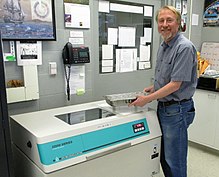Richard Lenski
Richard Eimer Lenski (born August 13, 1956 ) is an American evolutionary biologist .
Life
Richard E. Lenski is the son of the sociologist Gerhard Lenski .
He earned his Bachelor of Science degree from Oberlin College in 1976 and his PhD from the University of North Carolina in 1982 . From 1985 he was first assistant professor and from 1988-1991 associate professor at the University of California, Irvine . Since 1991 he has been a Distinguished Hannah Professor at Michigan State University .
He is a member of the American Academy of Microbiology (AAM) of the American Society for Microbiology (ASM), of the American Academy of Arts and Sciences since 1998 and of the European Molecular Biology Organization since 2017 . In 1996 he received a MacArthur Fellowship and was elected to the National Academy of Sciences in 2006 and to the American Philosophical Society in 2018 . He was co-editor of Theoretical Population Biology (1990–1992), Evolution (1990–1996), Microbial Ecology (1991–1999), Molecular Ecology (1994), The American Naturalist (1996–1998) and a member of several commissions: National Research Council Commission on Life Sciences (1990-1996), National Research Council Board on Biology (1991-1993), National Science Foundation Population Biology Review Panel (1995), Society for the Study of Evolution (1997).
Research area
In addition to his work with digital organisms under Avida , Lenski became known through a long-term experiment on the evolution of Escherichia coli , which he began on February 15, 1988. He regularly publishes information on the course of the experiment on his website.
E. coli long-term experiment

The E. coli - long-term experiment to document how natural selection (Engl. Survival of the fittest , dt. The survival of the adapted best organism ), the paradigm of evolutionary theory of Charles Darwin , in the laboratory is understandable and observable.
The model organism is Escherichia coli . This gut bacterium uses glucose as a natural source of nutrition; the wild type of E. coli cannot grow with citrate as a carbon source . Lenski has been exposing E. coli to a growth medium that contains a minimal amount of glucose but an oversupply of the non-metabolisable food source citrate without drastic external influences - such as harsh radiation or mutagenic chemicals - since 1988 .
All steps are carried out according to standard protocols. In the first step - based on a single prokaryotic E. coli cell that divided several times - Lenski selected twelve daughter cells that served as the starter for each of the twelve experiments that have been pursued in parallel since 1988:
- Every day the E. coli cultures are divided and provided with fresh medium ("propagated").
- Samples of the E. coli population are taken every 75 days (approximately 500 generations) and frozen for documentation.
- In these populations, the growth rate (relative to the original population) is estimated. If E. coli does not change, the growth rate should not change either. Should the growth rate increase, however, E. coli would have adapted to the new food source through random mutation (s).
In June 2008, Lenski et al. Published that after 31,500 generations in one of the twelve parallel experiments, an E. coli population had developed that is able to use citrate as a carbon source.
The genetic mutations that have led to this completely new ability of E. coli are currently being investigated in the new E. coli strain and its predecessor generations, which have been frozen over the last 20 years.
Individual evidence
- ↑ Michigan State University press release (in English) ( Memento of the original from August 15, 2007 in the Internet Archive ) Info: The archive link was automatically inserted and has not yet been checked. Please check the original and archive link according to the instructions and then remove this notice.
- ^ ZD Blount, CZ Borland, RE Lenski: Historical contingency and the evolution of a key innovation in an experimental population of Escherichia coli. In: Proceedings of the National Academy of Sciences . Volume 105, number 23, June 2008, ISSN 1091-6490 , pp. 7899-7906, doi: 10.1073 / pnas.0803151105 , PMID 18524956 , PMC 2430337 (free full text).
- ^ RE Lenski: Evolution in action: a 50,000-generation salute to Charles Darwin. In: Microbe. 6, 2011, pp. 30-33. PDF ( page no longer available , search in web archives ) Info: The link was automatically marked as defective. Please check the link according to the instructions and then remove this notice.
Web links
- Homepage of Richard E. Lenski (in English)
- E. coli Long Term Project in Experimental Evolution
- The long-term experiment in the science blog The Loom : A New Step In Evolution (in English)
| personal data | |
|---|---|
| SURNAME | Lenski, Richard |
| ALTERNATIVE NAMES | Lenski, Richard Eimer (full name) |
| BRIEF DESCRIPTION | American evolutionary biologist |
| DATE OF BIRTH | August 13, 1956 |
